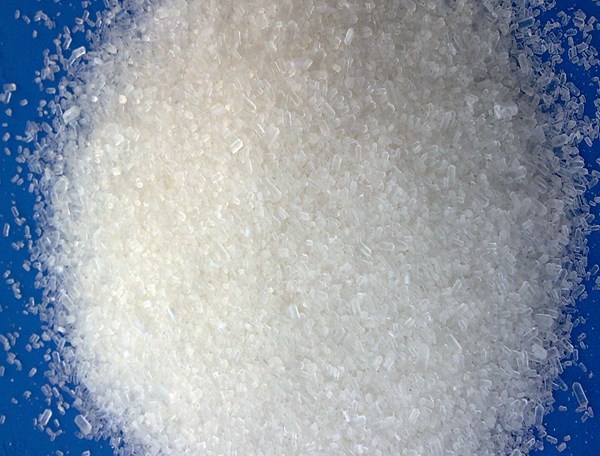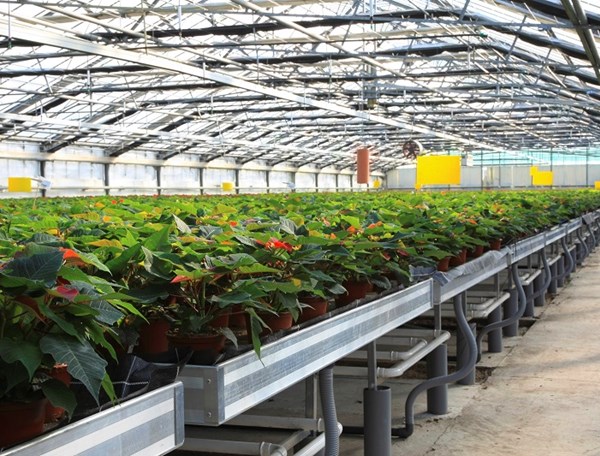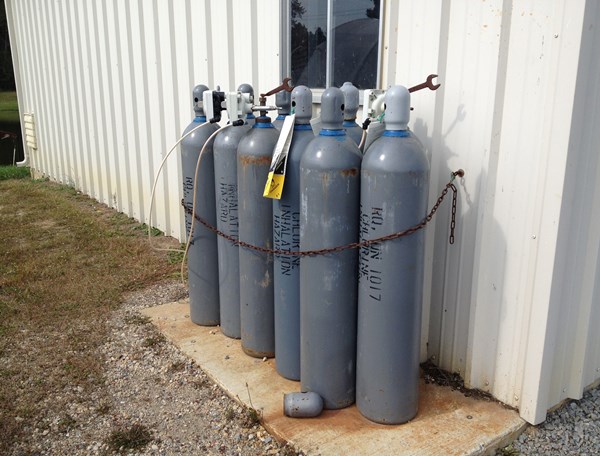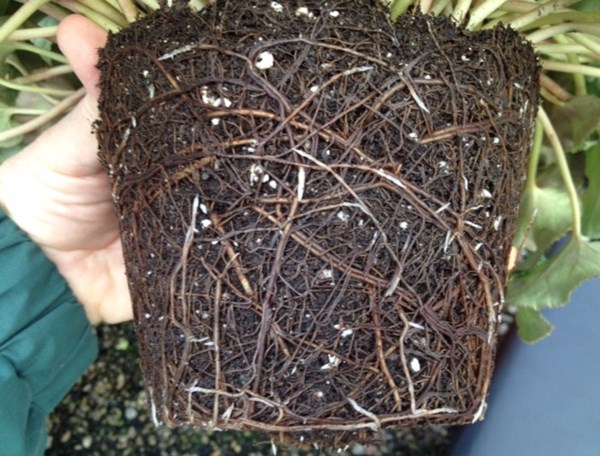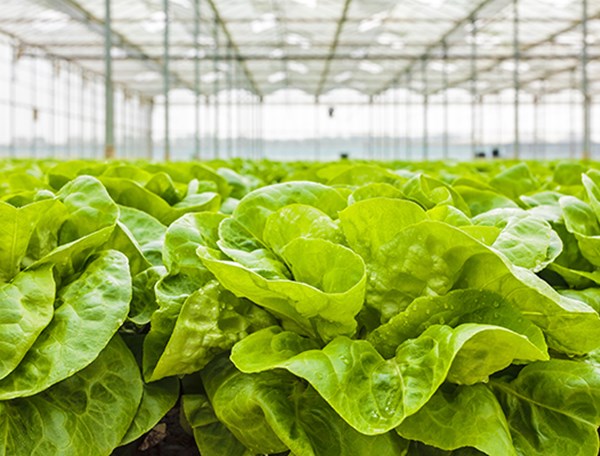Training Center
Acid Choices for Reducing Water Alkalinity
Thursday, September 7, 2023 | Troy Buechel
PDF version of this text: Acid Choices for Reducing Water Alkalinity

Some water sources cause the pH of a growing medium to rise rapidly over time. This has nothing to do with the pH of the water, but rather with the alkalinity in the water. Alkalinity is a measure of the bicarbonates and carbonates in the water. Another way to understand water alkalinity is that it is a measure of the ‘’limestone’’ content in the water. The higher the alkalinity, the more ‘’limestone’’ that is being applied, causing the pH of the growing medium to climb. To offset this pH rise, acids are injected into the irrigation water to neutralize some of the alkalinity and reduce the ‘’limestone’’ content in the water. Here are some important tips to consider when choosing an acid.
Selecting an Acid
When deciding which acid to use, there are several factors to consider including safety, additional plant nutrients provided, cost, and availability. The most common acids used to reduce water alkalinity include sulfuric, nitric, phosphoric and citric acids. For these 4 acids: see how much is required to drop the alkalinity of the water by 50 ppm CaCO3, the nutrients provided, relative safety, and cost (Table 1).
| Acid | % Active ingredient | Fl. ounces/100 gallons water to neutralize 50 ppm alkalinity | ppm element supplied | Relative safety* | Cost ** |
| Citric Acid (h3C6H5O7) | 50% | 1.78 oz. | None | 1 | $$$ |
| Nitric Acid (h3 NO3) | 67% | 0.87 oz. | 14.3 ppm N | 5 | $$ |
| Phosphoric Acid (H3PO4) | 75% | 0.94 oz. | 27.5 ppm P | 3 | $$ |
| Sulfuric Acid (H2 SO4) | 35% | 1.42 oz. | 16.1 ppm S | 3 | $ |
Table 1. *Relative safety: 1 = fairly safe; 5 = very dangerous **Cost: $ = least expensive; $$$ = most expensive
Nutrients Provided by Acid
Table 1 shows the parts per million (ppm) of the element supplied by each acid. Citric acid does not provide any significant levels of elements. Nitric and phosphoric acids provide needed plant nutrients that are often provided solely by fertilizers. When using a higher rate of an acid, it can provide a significant level of a plant nutrient as seen in Table 1, so a fertilizer with a lower ratio of this element may need to be used.
In the case of nitric acid, this may mean reducing the application rate of an existing fertilizer. If this does not work, then use a fertilizer with a lower ratio of nitrogen to potassium, such as 15-2-20, 15-5-25, 17-5-24, 20-5-30, etc. Remember that using a new fertilizer may have a different influence on the pH of the growing medium.
When using phosphoric acid, higher rates can provide more phosphorus than crops require. Most crops only need 20 ppm P (45 ppm P205), so if enough acid is injected to reduce alkalinity by 50 ppm CaCO3, then too much phosphorus is applied at 27.5 ppm. Extra phosphorus will not harm the crop, but it can lead to stretching and softer growth. If phosphoric acid is used, consider using a fertilizer with no phosphorus, such as 17-0-17, 20-0-20, 25-0-25, etc.
Sulfuric acid provides sulfur in the form of sulfate, which is needed by plants and is often low in water sources and fertilizer programs. Therefore, high rates of sulfuric acid do not cause any issues with the crops as the normal recommended range for sulfur (sulfate) is 25-60 ppm sulfur (75-180 ppm sulfate). For these reasons, and the fact that it is typically the least expensive, sulfuric acid is the choice of most growers.
Tips on Mixing Acid
It is best to inject acid directly from a concentrate barrel into the irrigation line so there is no handling. This is the safest option. If acid must be diluted with water first before injecting, remember to add acid to water, and not water to acid as it will cause dangerous reactions. Although these acids are liquids, they are heavier than water and will settle at the bottom of the tank, so it must be stirred to dissolve into the water. Remember acid is caustic to metal parts, so consult your fertilizer injector manufacturer to make sure your injector is compatible for injecting acid.
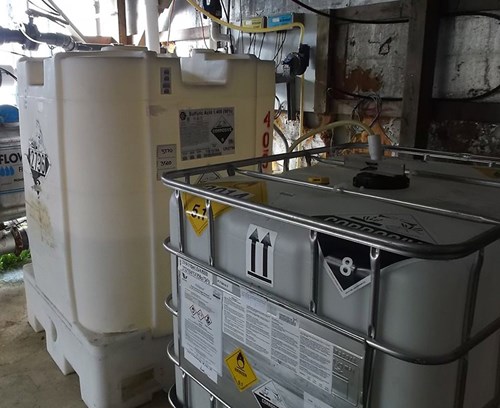
Acid is being directly injected from these two acid tanks into the irrigation water. This is safer than having to mix it with water. Source: Premier Tech.
Concentrated acid could be added directly to the stock solution of some fertilizers, but not all. Sulfuric or phosphoric acids cannot be added to the stock solution of a calcium-based fertilizer, as precipitates of calcium sulfate or calcium phosphate, respectively, will form. However, a little acid can be added to a fertilizer stock solution to drop the pH of the water to help the fertilizer to dissolve. Often, citric acid is used for this purpose since it does not provide nutrients that can form precipitates.
Acid Safety
Citric acid is the safest of the acids to use, followed by sulfuric and phosphoric. Keep in mind the more concentrated the acid (higher percentage of active ingredient), the more caustic and dangerous it will be. With any of these acids, avoid contact with the skin or eyes as it can cause irritation or even minor burns. These acids can damage clothing by forming holes after clothing is washed. Nitric acid is much more caustic and will burn skin or eyes. It can also produce hazardous fumes that should not be breathed in. When working with any acid, it is best to wear safety glasses, a face shield, acid resistant gloves, and an apron.
Note: Since Premier Tech does not manufacture acidifiers, we invite you to consult your manufacturer for specific information concerning the use of their products.
For more information, contact your Premier Tech Grower Services Representative:
 |
 |
 |
 |
|---|---|---|---|
|
Ed Bloodnick |
Nathan Wallace-Springer |
Lance Lawson |
Victor Brantly |
 |
 |
 |
|
|
Troy Buechel |
Susan Parent |
Jose Chen Lopez |
PRO-MIX® is a registered trademark of PREMIER HORTICULTURE Ltd.
Related Articles
-
MYTH Series: Epsom Salt Decreases the pH of Growing Media
Epsom salt is used by many growers as a fertilizer supplement to provide magnesium and sulfate when they are low in the fertilizer solution.
-
MYTH Series: Sulfur Drops the pH of Growing Media
In the horticultural industry, many myths exist that can greatly affect how containerized crops are grown in the greenhouse environment.
-
Water Sanitation Part 3a: Oxidizers Used for Water Sanitation
This article will focus on oxidizing agents used to sanitize greenhouse irrigation water.
-
Water Sanitation Part 1: Biology of Pathogens in Water Sources
Sanitation is a key to restricting plant pathogen introduction and spread. In this first of a three part series on water sanitation, we will discuss the importance of knowing the biology of root rot pathogens.
-
Water Sanitation Part 2: Pre-Treating Water Before Sanitation
We often think of water quality from the standpoint of chemical properties, such as alkalinity, mineral elements, pH, etc.


 Where to find our products
Where to find our products
